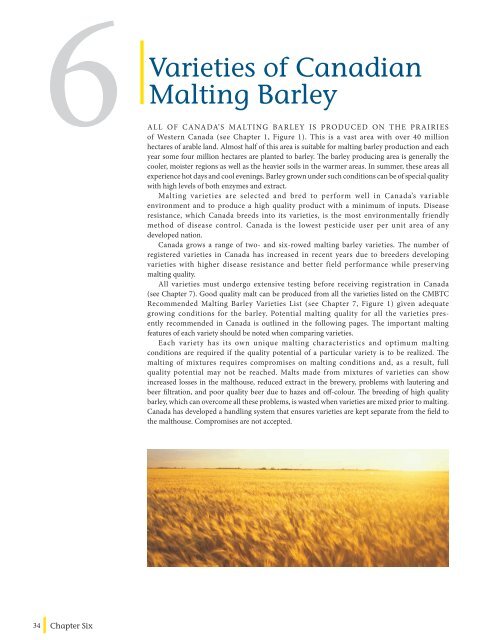MALTING QUALITY TRAITS - Canadian Malting Barley Technical ...
MALTING QUALITY TRAITS - Canadian Malting Barley Technical ...
MALTING QUALITY TRAITS - Canadian Malting Barley Technical ...
Create successful ePaper yourself
Turn your PDF publications into a flip-book with our unique Google optimized e-Paper software.
34<br />
6 ALL<br />
Chapter Six<br />
Varieties of <strong>Canadian</strong><br />
<strong>Malting</strong> <strong>Barley</strong><br />
OF CANADA’S <strong>MALTING</strong> BARLEY IS PRODUCED ON THE PRAIRIES<br />
of Western Canada (see Chapter 1, Figure 1). This is a vast area with over 40 million<br />
hectares of arable land. Almost half of this area is suitable for malting barley production and each<br />
year some four million hectares are planted to barley. The barley producing area is generally the<br />
cooler, moister regions as well as the heavier soils in the warmer areas. In summer, these areas all<br />
experience hot days and cool evenings. <strong>Barley</strong> grown under such conditions can be of special quality<br />
with high levels of both enzymes and extract.<br />
<strong>Malting</strong> varieties are selected and bred to perform well in Canada’s variable<br />
environment and to produce a high quality product with a minimum of inputs. Disease<br />
resistance, which Canada breeds into its varieties, is the most environmentally friendly<br />
method of disease control. Canada is the lowest pesticide user per unit area of any<br />
developed nation.<br />
Canada grows a range of two- and six-rowed malting barley varieties. The number of<br />
registered varieties in Canada has increased in recent years due to breeders developing<br />
varieties with higher disease resistance and better field performance while preserving<br />
malting quality.<br />
All varieties must undergo extensive testing before receiving registration in Canada<br />
(see Chapter 7). Good quality malt can be produced from all the varieties listed on the CMBTC<br />
Recommended <strong>Malting</strong> <strong>Barley</strong> Varieties List (see Chapter 7, Figure 1) given adequate<br />
growing conditions for the barley. Potential malting quality for all the varieties presently<br />
recommended in Canada is outlined in the following pages. The important malting<br />
features of each variety should be noted when comparing varieties.<br />
Each variety has its own unique malting characteristics and optimum malting<br />
conditions are required if the quality potential of a particular variety is to be realized. The<br />
malting of mixtures requires compromises on malting conditions and, as a result, full<br />
quality potential may not be reached. Malts made from mixtures of varieties can show<br />
increased losses in the malthouse, reduced extract in the brewery, problems with lautering and<br />
beer filtration, and poor quality beer due to hazes and off-colour. The breeding of high quality<br />
barley, which can overcome all these problems, is wasted when varieties are mixed prior to malting.<br />
Canada has developed a handling system that ensures varieties are kept separate from the field to<br />
the malthouse. Compromises are not accepted.


